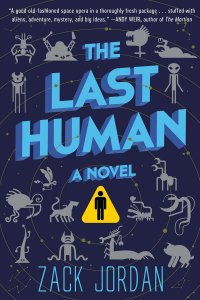Paul Di Filippo Reviews The Last Human by Zack Jordan
 The Last Human, Zack Jordan (Del Rey 978-0451499813, $27.00 448pp, hardcover) March 2020.
The Last Human, Zack Jordan (Del Rey 978-0451499813, $27.00 448pp, hardcover) March 2020.
Zack Jordan’s debut novel is a highly accomplished postmodern space opera that manages to adroitly blend the SF humor of Robert Sheckley and Douglas Adams with the pathos of Simon Jimenez (The Vanished Birds) and the state-of-the-art high-tech speculative ambiance of Peter Hamilton and Alistair Reynolds. Additionally, it resonates with that great SF novum of humans as an underdog minority (even a minority of one!) in the galactic milieu, as seen in such classics as Laumer & Brown’s Earthblood, Heinlein’s Have Space Suit—Will Travel and Citizen of the Galaxy, and in more recent works like James Cambias’s Arkad’s World.
The narrative is divided into five sections labeled “Tier One” through “Tier Five.” Since in Jordan’s scenario all sapient intelligences in the galaxy are ranked from Tiers One to Five, the book promises an escalation of complexity, and it pretty much delivers on that promise. This stratification and privileging of brainpower also calls up a couple of past landmarks, creating a further richness of historical allusion: Vernor Vinge’s Zones of Thought series and an oft-overlooked gem, Delany’s Empire Star, with its “simplex/complex/ multiplex” distinctions.
Our opening venue is an orbital water-mining station named Watertower. Here live some 24,000 assorted citizens, including a deadly giant spider-like creature with bladed appendages, Shenya the Widow. Shenya has under her parental guidance a most unlikely child, Sarya the Human. (The intricate backstory of how the pair became affiliated will be delivered midbook, through the ingenious method of Sarya receiving a memory implant from her “mother.”) Sarya’s humanity must remain a secret, since her whole race was earlier wiped out as a danger to the Network, the polity that binds together a billion planets and trillions of beings.
Jordan introduces us to the parameters of Sarya’s angsty adolescent life very adroitly and naturally, taking her on a field trip with her classmates, of all “mundane” things. Soon we have a great sense of her individuality, her desires and regrets, angers and pleasures. But all this is about to be overturned. Watertower Station is going to be destroyed—a mysterious being named Observer and his minion Hood appear to be the culprits—and Sarya will become separated from her mother. Her temporary refuge is a giant mecha suit named Eleven, which proves to be a blithe host.
[This] figure is all gleaming curves. From the stubby tripod of its three heavy legs to the top of its dome, this thing is easily twice her height and nearly all shining torso. There is no head, just a continuous curved surface broken only by two pairs of arms. One set is as massive as the suit itself; they emerge nearly three meters up the massive body and run down its entire length to rest on the deck. The other pair is smaller; they fold across a giant number as on its gleaming front. This is not a budget suit, that’s for sure, and for some reason that makes her trust this Hood just a little more. As she watches, a ring of transparent light flickers to life halfway up this leviathan. The words AIVV-TECH QUALITY IS WORTH THE WAIT orbit it a few centimeters out from its gleaming surface. And then, with a bone-shaking clang, the machine falls forward onto its two largest arms. Two spotlights pin her to the floor while the small arms on the suit’s front unfold and wave cheerily. “Hello!” booms a cheerful yet enormous voice that rings across the empty dock. “Thank you for choosing an AivvTech Universal Autonomous Environment! How can this unit improve your day”
Sarya steps forward, shielding her eyes. “Um…hi,” she says when the echoes have died away. “Nice…to meet you?”
“This suit contains sub-legal auxiliary intelligence,” says the chipper voice, “but that doesn’t mean it can’t serve you well! For instance: are you tired of unexpected atmosphere evacuations and uncomfortable implosions? Does manually transporting your own body exhaust you? With the AivvTech UAE, these problems are relics of the past! Simply give this suit your orders and it will do the rest, and it can do so anywhere from perfect vacuum to crushing magma! And if you are looking for entertainment options then look no further, because—”
I quote at length to illustrate the kind of sophisticated tragicomic tone that Jordan employs successfully throughout. It’s one of the book’s major charms. (Another great instance occurs with a kind of Outer Space Tugboat Captain who manages to sound like famed Right Stuff pilot Chuck Yaeger.)
Enclosed in Eleven, Sarya survives the destruction of her habitat and ends up on a trading ship named Riptide, with a motley three-being crew that reminded me of Poul Anderson’s Van Rijn tales. Alone in the big and busy universe, not knowing who’s friendly and who’s deadly, Sarya must survive long enough to fulfill her destiny as the last human. But once she discovers the secret behind Network—a hint: it involves massive Artificial Intelligences—it’s more a matter of becoming the first posthuman rather than remaining the last human.
Jordan conveys the antiquity and complexity of his galactic civilization with plenty of panache. (Interstitial encyclopedia or operating manual selections provide context.) The Blackstar Dyson Sphere is a case in point. “You’ll need room to park a few trillion vehicles. A diameter of a hundred fifty million kilometers should do the trick.” He plays nicely with augmented reality tricks. His various alien biologies are convincing. And all the characters interact intriguingly. There’s a great bit where Sarya wants to have a conversation with a higher-tier being, and we watch her interlocutor mentally play out the whole conversation before she can even speak, rather like Robert Downey as Holmes foreseeing all of his opponents moves in speeded-up fashion.
One small quibble: do not expect a grand Galactic Tour in this adventure. Basically, there are about three or four limited venues that contain all the action, some of them virtual. Jordan promises further exploits for Sarya, and we sense he’s saving more expansive vistas for later books.
Following the archetypical path of a Joseph Campellian hero’s quest, Sarya brings us along on a unique and thrilling ride that even a smart suit like Eleven could not manage.
 While you are here, please take a moment to support Locus with a one-time or recurring donation. We rely on reader donations to keep the magazine and site going, and would like to keep the site paywall free, but WE NEED YOUR FINANCIAL SUPPORT to continue quality coverage of the science fiction and fantasy field.
While you are here, please take a moment to support Locus with a one-time or recurring donation. We rely on reader donations to keep the magazine and site going, and would like to keep the site paywall free, but WE NEED YOUR FINANCIAL SUPPORT to continue quality coverage of the science fiction and fantasy field.







